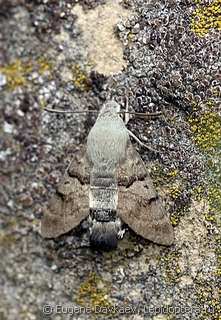Macroglossum stellatarum

Taxonomy
class Insecta
Species name(s)
Macroglossum stellatarum (Linnaeus, 1758) = Sphinx stellatarum Linnaeus, 1758 = Sphinx flavida Retzius, 1783 = Macroglossa nigra Cosmovici, 1892 = subnubila Schultz, 1904 = fasciata Rebel, 1910 = convergens Constantini, 1916 = approximata Lempke, 1959 = clausa Lempke, 1959 = candidum Eitschberger, 1971 = minor Vilarubia, 1974. [9, 10]
Humming-bird Hawk-moth.
urn:lsid:insecta.pro:taxonomy:2839
Expansion
This species marks on the maps: 3.
Zoogeographical regions
Palaearctic.
Russia regions
#1. Kaliningradsky; #3. Karelsky; #4. Evropeisky Severo-Zapadny; #7. Evropeisky yuzhno-tayozhny; #8. Evropeisky Tsentralny; #9. Evropeisky Tsentralno-Chernozyomny; #10. Sredne-Volzhsky; #11. Volgo-Donsky; #12. Nizhnevolzhsky; #13. Zapadno-Kavkazsky; #14. Vostochno-Kavkazsky; #16. Sredne-Uralsky; #17. Yuzhno-Uralsky; #20. Yuzhno-Zapadnosibirsky; #22. Krasnoyarsky; #23. Predaltaisky; #24. Gorno-Altaisky*; #38. Sakhalin; #40. Primorsky.
* An asterisk denotes a region for which the species is listed as an migrant or information that requires additional checking.
Forewing length
20—25 mm.
Primary colors
Orange, Brown/Gray/Black.
Flight time
| January | February | March | April | May | June | July | August | September | October | November | December |
Larva lifespan
| January | February | March | April | May | June | July | August | September | October | November | December |

Detailed information with references
Distribution
Imago Habitus and Differences from alike species
General info about Imago
Imago lifespan
Larva food plants / other food objects
Larva lifespan
Authors
Initial species uploading to the site: Peter Khramov.
Text data: Peter Khramov.
The species characteristics formalization: Peter Khramov.
References
- [1] O. Karsholt, J. Razowski (eds.), 1996. The Lepidoptera of Europe: a distributional checklist
- [3] Каталог чешуекрылых (Lepidoptera) России. Под ред. С. Ю. Синёва. СПб.; М.: Товарищество научных изданий КМК, 2008
- [5] Райххолф-Рим Х. Бабочки. М.: Астрель, 2002
- [9] Tree of Life (funet.fi), 2012
- [10] de Jong, Y.S.D.M. (ed.) (2011) Fauna Europaea version 2.4 (faunaeur.org)
- [28] Moths and Butterflies of Europe and North Africa (leps.it), 2012
Comments
Note: you should have a Insecta.pro account to upload new topics and comments. Please, create an account or log in to add comments
Macroglossum stellatarum photos

















































All the photos of the species in large size
Please, create an account or log in to upload your photo








